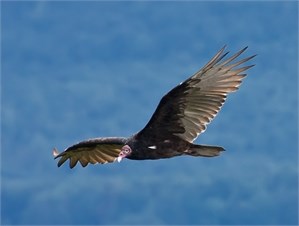Online 'vulture marathon' begins
Posted on March 15, 2013 in Education

Anyone with interest in the outdoors--and an Internet connection--can now track the migratory movements of turkey vultures breeding in Pennsylvania, central Canada, the Pacific Northwest and Argentina, thanks to Hawk Mountain Sanctuary researchers and their long-term studies of this scavenging clean-up crew. Biologists at the Sanctuary say late March is a great time to tune in to the birds’ seasonal marathon journeys back to their breeding grounds (in North America) and their wintering grounds (in South America).
To monitor vulture movements, visit hawkmountain.org/maps and click on "Follow tracking maps." You will then be able to follow the movements of birds with active tracking devices.
“In North America, vultures are beginning to move north to their breeding grounds—or as in the case of about half of our Pennsylvania birds, they may not move at all,” explains Dr. Keith Bildstein, Sarkis Acopian Director of Conservation Science at Hawk Mountain. Vultures breeding in central Canada travel the farthest, shuttling more than 6,000 miles between northern Venezuela and south-central Saskatchewan.
“In Argentina, where the birds are experiencing the onset of winter, they are also moving north toward warm Equatorial areas in Bolivia and Brazil, a Southern Hemisphere migration behavior Hawk Mountain first documented for the first time in 2011,” he adds. Last year vultures tracked in South America traveled as far as 2000 miles between their breeding and over-wintering areas.
Hawk Mountain has been tracking turkey vultures by satellite in North America since 2003 and in South America since 2009. Individual donors provide the funds for each satellite unit, and most birds are named by or in honor of their donor.
"We're grateful to our donors because the units cost upwards of $4,000 each," Bildstein says. "The added bonus is that the resulting data are used not only by Sanctuary scientists, but also by school teachers countrywide, who used the movements in their classrooms to teach geography, math and avian ecology," Bildstein explains.
Bildstein says that Hawk Mountain scientists are tracking the birds to learn more about the species movement ecology and the factors that affect it, including climate change. Initial results indicate that turkey vultures have one of the most geographically flexible of all avian migration systems.
People can get in on the action by being on the lookout for vultures with colored and numbered wing-tags. Reports can be sent to [email protected] and should include the date, location, and the color and number on the tag.
Bildstein said that although it's safe to say the birds don't know each other's locations, most researchers believe getting to a preferred wintering or breeding area first will help a migrant secure the best site for survival, which means, in an ecological sense, that the birds are racing for just the right spots.
"This migration marathon is one that promises to be a flight to the finish," said Bildstein.